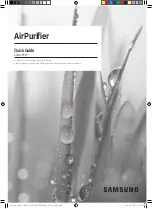
Page 9
WARNING
Polyol ester (POE) oils used with R410A refrigerant
absorb moisture very quickly. It is very important
that the refrigerant system be kept closed as much
as possible. DO NOT remove line set caps or ser-
vice valve stub caps until you are ready to make
connections.
Brazing Connection Procedure
1 − Cut ends of the refrigerant lines square (free from nicks
or dents). Debur the ends. The pipe must remain
round, do not pinch end of the line.
2 − Before making line set connections, use dry nitrogen to
purge the refrigerant piping. This will help to prevent
oxidation and the introduction of moisture into the sys-
tem.
3 − Use silver alloy brazing rods (5 or 6 percent minimum
silver alloy for copper−to−copper brazing or 45 percent
silver alloy for copper−to−brass or copper−to−steel braz-
ing) which are rated for use with R410A refrigerant.
Wrap a wet cloth around the valve body and the copper
tube stub. Remove light maroon washers from service
valves and shield light maroon stickers in order to pro-
tect them during brazing. Braze the line set to the ser-
vice valve.
4 − Wrap a wet cloth around the valve body and copper
tube stub to protect it from heat damage during braz-
ing. Wrap another wet cloth underneath the valve body
to protect the base paint.
Quench the joints with a wet cloth to prevent possible
heat damage to the valve core and opening port.
NOTE − The tube end must stay bottomed in the fitting
during final assembly to ensure proper seating, sealing
and rigidity.
5 − Install the provided
fixed orifice (or thermal expan-
sion valve which is sold separately and approved
for use with R410A refrigerant)
in the liquid line at the
indoor coil.
6 − Install the provided filter drier (approved for use with
R410A refrigerant) in the liquid line as close as pos-
sible to the expansion device.
Do not leave the filter
drier uncapped for more than 10 to 15 minutes
prior to brazing, evacuation, and leak testing.
Polyol ester oils used in this system absorb mois-
ture quickly. Failure to install the filter drier will
void the warranty.
Flushing Existing Line Set & Indoor Coil
WARNING
Danger of fire. Bleeding the refrigerant
charge from only the high side may
result in the low side shell and suc-
tion tubing being pressurized. App-
plication of a brazing torch while pres-
surized may result in ignition of the
refrigerant and oil mixture − check the
high and low pressures before unbra-
zing.
IMPORTANT
If this unit is being matched with an approved line
set or indoor coil which was previously charged
with mineral oil, or if it is being matched with a coil
which was manufactured before January of 1999,
the coil and line set must be flushed prior to instal-
lation. Take care to empty all existing traps. Polyol
ester (POE) oils are used in Lennox units charged
with R410A refrigerant. Residual mineral oil can act
as an insulator, preventing proper heat transfer. It
can also clog the expansion device, and reduce the
system performance and capacity.
Failure to properly flush the system per the instruc-
tions below will void the warranty.
CAUTION
This procedure should not be performed on sys-
tems which contain contaminants (Example: com-
pressor burn out).
Required Equipment
You will need the following equipment in order to flush the
existing line set and indoor coil: two clean R22 recovery
bottles, an oilless recovery machine that has a pump down
feature, and two sets of gauges (one for use with R22 and
one for use with the R410A).
Flushing Procedure
1 − Remove existing R22 refrigerant using the appropri-
ate procedure below.
If the existing outdoor unit is not equipped with
shut−off valves, or if the unit is not operational
AND you plan to use the existing R22 refrigerant
to flush the system −
Disconnect all power to the ex-
isting outdoor unit. Connect to the existing unit, a





































